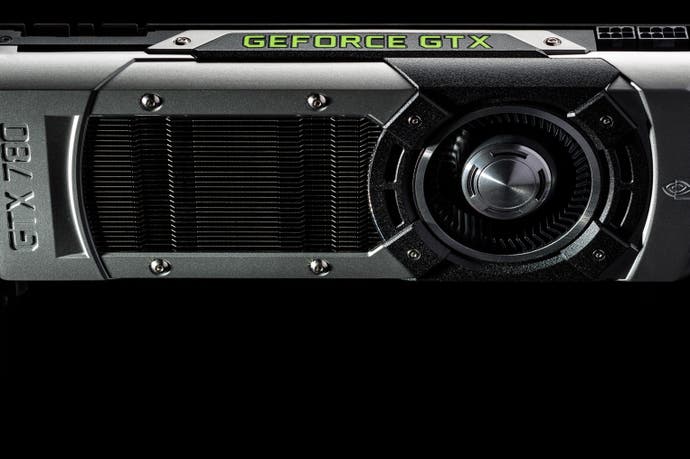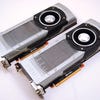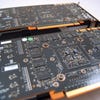Nvidia GeForce GTX 780 review
Titanic.
Nvidia's GeForce GTX Titan ushered in a new era of single-chip GPU performance - the ultimate example of the power and performance of the firm's wildly successful "Kepler" architecture. But that level of pure GPU grunt came at a cost - a vast one. Titan retailed at £850 in the UK and $1000 in North America. Nvidia had defined a new "luxury" price point for its most capable graphics card, but the price vs. performance maths just didn't work out - Titan was twice the cost of the GTX 680 for just a 50 per cent boost in frame-rates.
Despite that, the allure of Titan was difficult to resist for the ultra-hardcore enthusiast - Nvidia sold every unit it produced. Indeed, Titan even outsold the more powerful dual-GPU GTX 690, which retailed at the same price. However, we've got the feeling that this rush for the gold standard in gaming performance from the most committed of PC gamers may now be coming to a close with the release of the new GTX 780.
The GTX 780 lops off £300/$350 from the price of the Titan, but in many ways it is exactly the same product - the same PCB, the same premium, magnesium-effect aluminium casing, the same ultra-quiet cooling system and crucially the same 7.1-billion transistor GK110 processor.
Performance-wise, there have been nips and tucks though. At stock speeds, you're basically getting 90 per cent of the raw graphical power for 65 per cent of the price. Titan's 2688 CUDA cores gets a haircut down to 2304, while the 224 texture units are pared back to 192. The biggest cutback comes from the GDDR5 allocation - it's 6GB on Titan, and 3GB on the GTX 780. In our testing we found that this made no difference at all, but as next-gen kicks in, RAM allocation may well become more important. On the plus side, the reduction in CUDA cores gives the GTX 780 a little more room to breathe within its 250W TDP power budget, meaning that both core clock and the auto-overclocking boost clock are a little higher than Titan.
The only other major difference between the Titan and the GTX 780 comes down to raw Compute performance. In order to preserve the top-end offering's charms as a super-computer surrogate, double-precision floating performance (FP64) has been ruthlessly nerfed, giving Titan a huge advantage here. However, for our main purposes - gameplay - there are no savage cutbacks at all, and bearing in mind the cost saving, it's really difficult to recommend Titan at all now.
"All the high-end workmanship on the shell, cooling and acoustics of the Titan has been transferred to the new GTX 780 with no real compromises."
As the price moves down for top-tier performance, the comparisons with the existing 680 become a lot more valid, and it's here that the clear leap in specs over the current, "affordable" state-of-the-art is truly pronounced - 2304 CUDA cores vs. 1536 in the GTX 680, 192 texture units vs. 128, 38 ROPs vs. 32. The GTX 680's only real advantage is clock speed - its operating speed hovers around 1GHz, 20 per cent or so faster.
Having attended Nvidia's press briefing on the new card, it seems that the company is very keen indeed on evangelising its latest line to those still gaming on older GPU technology and it's easy to see why. GTX 680 offered a generational leap in power and performance over its predecessor and, factoring in the Titan-class performance offered by the GTX 780, the older GTX 580 doesn't stand a chance. Nvidia reckons that we're looking at a boost of almost 70 per cent, and based on the few isolated tests we carried out, it easily meets the target in almost all modern games.
But the real story here is the notion that Nvidia is effectively giving away something very close to Titan performance with a substantial price cut, so let's put that to the test, kicking off with a quick test in actual gameplay conditions. There's no better game for testing a high-end GPU than Crytek's Crysis 3, set to the very high quality preset. Anti-aliasing can still bring frame-rates crashing down - even if you're running three Titans in SLI - so we've opted for SMAA 2x owing to its excellent results at high resolutions and its very light impact on GPU performance. For resolution, we're going with 2560x1440 - the 2.5K standard that's swiftly becoming very affordable, and represents a tangible leap in detail over the de facto standard 1080p.
Our test system here is a Core i7 3770K overclocked to 4.3GHz combined with 1600MHz DDR3 RAM operating in dual-channel configuration. 3DMark benches the entire system which isn't entirely relevant for a GPU shoot-out, so we've reserved our analysis for the graphics scores only.
"The GTX 780's proximity to the performance of the much more expensive Titan is borne out by our challenging outdoors Crysis 3 playtest."
Alongside Metro: Last Light, Crysis 3 is one of the most technologically demanding PC games on the market right now, so you'd hope to see some kind of gap open up between the two systems, but you'll note that in the like-for-like scenes shown in this video, we're only really seeing a 2-4FPS difference. Beyond 40FPS, it's quite difficult for the human eye to pick up on the variation between the two captured streams when they're played back side-by-side at full frame-rate. Only when the action is really intense and the frame-rate dips below that threshold does the perceptual nature of the Titan's advantage actually manifest to any kind of meaningful degree.
Crysis 3 has the advantage over Metro: Last Light in that a vast array of tweakables are available in the advanced graphics menu, so while the very high preset rules out 60FPS (you'll need SLI for that), you can at least experiment with individual settings to create a hybrid high/very high set-up that should get you closer to the 60Hz ideal, or indeed on a smaller level to bring GTX 780 performance up to that of the Titan. The law of diminishing returns on ultra-high PC graphics settings is something we're looking into covering more extensively in the future.
But returning to the topic at hand, it's clear to see that we are indeed getting most of the Titan experience from the much cheaper GTX 780. But to what extent can the Titan's hardware advantages be quantified by actual applications? We'll start out by firing up our favourite synthetic benchmark - Futuremark's latest 3DMark, utilising the extreme version of the Fire Strike battery of tests, swiftly followed up with the now classic 3DMark 11, again with the extreme settings focus.
"3DMark scores confirm that GTX 680 is left well behind, with the new GTX 780 scoring closely to the more powerful Titan."

| GTX 680 | GTX 780 | GTX Titan | |
|---|---|---|---|
| 3DMark Fire Strike Graphics Score | 3219 | 4321 | 4715 |
| 3DMark11 Graphics Score | 3092 | 4259 | 4611 |
All told, the GTX 780 offers a good 25 per cent boost in performance in these tests compared to the GTX 680, and in turn we see the Titan maintaining its lead by around eight per cent over the 780. In short, if you're a GTX 680 owner you're still getting something close to a generational jump in performance by upgrading, but Titan retains its crown. The difference between the two top-end GPUs is very, very close indeed - we're reminded somewhat of the comparison between the GTX 670 and the GTX 680 - identical in so many ways and offering over 90 per cent of the raw power of the flagship model, but without the premium price-point tax.
So how does that notional boost in raw performance translate into actual game engines? Metro 2033 may be somewhat old now, but the Frontline benchmark is still an excessively brutal workout for top-end GPU hardware once full-on tessellation, advanced PhysX and vast resolutions are brought into play. When Metro: Last Light is updated with its own bespoke benchmark we'll move onto that, but in the meantime, this is as good a test as any in really putting top-end GPU hardware through its paces.
As with all our game engine tests, we also run them across a range of resolutions - 1080p, 2560x1440 and 3840x2160 (4K) - acknowledging that those spending over £400 on graphics hardware are likely to be running much higher-resolution displays than the now standard 1080p.
"Metro 2033's Frontline benchmark maintains its reputation for challenging even the most powerful modern graphics cards."

| GTX 680 | GTX 780 | GTX Titan | |
|---|---|---|---|
| 1920x1080 (PhysX On/Off) | 31FPS/30FPS | 44FPS/48FPS | 47FPS/50FPS |
| 2560x1440 (PhysX On/Off) | 18FPS/19FPS | 27FPS/29FPS | 30FPS/32FPS |
| 3840x2160 (PhysX On/Off) | Fail/Fail | 13FPS/12FPS | 14FPS/13FPS |
If you rule out 4K and dial back on the 4x MSAA and tessellation, it's safe to say that you can play Metro 2033 on a GTX 680 at virtually any resolution you want - but equally it's the case that opting for a premium price-point GPU does prompt you to opt for the higher-quality settings. In this stress test with everything ramped up the absolute max, we can see that the gulf in performance between the GTX 680 and GTX 780 remains pronounced, but the difference between the latest GeForce offering and Titan is limited to just two to three frames per second.
We see that same grey area of performance between Nvidia's two top-tier products in our second game-engine stress test - IO Interactive's Hitman: Absolution. The Glacier 2 engine absolutely revels in rendering sheer detail, particularly in the vast range of NPCs it's capable of cramming into any given scene. Here, we're running at ultra settings with the top-end 8x MSAA engaged and we're seeing a similar gulf between 680 and 780 and the same very, very close grouping of the Titan and 780 in our results. Indeed, in our 2560x1440 tests, we actually got the same result between the two cards.
Regardless though, Titan being unable to hit 1080p60 was something of an eye-opener, so we tried dialling back MSAA. Surprisingly, we only clawed back 2-3FPS by dropping down to 4x MSAA, and the same again dropping down to 2x MSAA. The 48 ROPS and 384-bit memory common to both cards clearly copes rather well with the enormous bandwidth requirements MSAA inflicts on an engine like this.
"Hitman: Absolution demonstrates that ultra settings can even challenge the GTX 780 and the Titan at 1080p."

| GTX 680 | GTX 780 | GTX Titan | |
|---|---|---|---|
| 1920x1080 | 34FPS | 48FPS | 51FPS |
| 2560x1440 | 20FPS | 31FPS | 15FPS |
| 3840x2160 | Fail | 12FPS | 15FPS |
There does seem to have been a trend in recent times to provide quality settings that are well beyond the capability of any GPU on the market - Metro: Last Light's super-sampling SSAA is a pretty good example of this, where even a 3x Titan SLI set-up simply cannot maintain anything approaching a consistent 60 frames per second at higher resolutions.
That said, there still plenty of new games out there where the ultra settings are still somewhat attainable for current level hardware. BioShock Infinite is a definite case in point, where 1080p60 at its maximum quality presets (even factoring in the optional DirectX 11 diffuse depth-of-field effect) is attainable by all of our test subjects.
It's noteworthy for another reason too in that we see the highest level of disparity between the GTX 780 and the Titan in any of our tests - a heady 7FPS at 1080p. Good news for those looking for Titan-level performance at a much lower price-point, but a statistic that may give pause for those who've already sunk £850 into the top-end Nvidia product not knowing that the GTX 780 would appear so soon after its debut.
"BioShock Infinite is relatively GPU light - even its absolute top-end ultra settings accommodate the GTX 680."

| GTX 680 | GTX 780 | GTX Titan | |
|---|---|---|---|
| 1920x1080 | 75FPS | 93FPS | 100FPS |
| 2560x1440 | 48FPS | 61FPS | 66FPS |
| 3840x2160 | 23FPS | 30FPS | 33FPS |
The notion of the GTX 780's hobbled Compute performance having any kind of impact in more exotic gaming tasks can also be dispelled. Taking a look at Tomb Raider running in ultra and ultimate modes, we again see very close results - despite the introduction of the Compute-centred TressFX hair simulation.
Tomb Raider's ultimate preset is essentially exactly the same as ultra, the only difference being the inclusion of Lara's more intensely detailed hair, and it's interesting to note that while super-sampling anti-aliasing is an option, it remains firmly disengaged even on the game's highest presets. Utilising RAM-intensive deferred shading, Tomb Raider employs high-quality FXAA anti-aliasing as the standard solution instead, which works beautifully at higher resolutions.
One thing we have learned during our testing is that while Nvidia and AMD are aggressively targeting performance per watt, game developers are still deploying ever more aggressive quality presets in order to differentiate the PC versions from the console editions of the same games. Anti-aliasing in particular is a vast tap on resources and Tomb Raider proves nicely that even fairly basic post-process AA tech is well up to the job at 1080p or higher. The introduction of next-gen console should be interesting - rather than scaling up effects or bundling in super-sampling AA, we'd hope to see the arrival of new rendering paradigms that could perhaps put all this GPU power to more effective, intelligent use.
"Titan's enhanced Compute capabilities appear to offer no gaming advantage over the cheaper GTX 780."

| GTX 680 | GTX 780 | GTX Titan | |
|---|---|---|---|
| 1920x1080 (TressFX On/Off) | 48FPS/78FPS | 69FPS/105FPS | 71FPS/112FPS |
| 2560x1440 (TressFX On/Off) | 31FPS/47FPS | 46FPS/66FPS | 47FPS/69FPS |
| 3840x2160 (TressFX On/Off) | 9FPS/20FPS | 21FPS/30FPS | 22FPS/31FPS |
Nvidia GeForce GTX 780: the Digital Foundry verdict
With Titan priced upwards of £800, it was always going to be a tough sell to all but the most privileged of PC gamers, but clearly the £550 price-point of the GTX 780 remains pretty expensive - the new card hit stores last week and it's around £100 more expensive than the GTX 680's debut cost. That being the case, the new card is not so much of a replacement for the GTX 680 as the arrival of a more realistic price-point for Titan-level performance. In short, Nvidia has simply created another "luxury" price tier, and we can expect a further 700-series product to be introduced in short order to pick up where the GTX 680 left off.
In relation to the GTX 680, and indeed the new GTX 770 which we'll be reviewing next week - you are at least getting a more realistic level of performance vs. price, but the fact is that with the lack of any kind of AMD rival available either now or indeed in the near future, Nvidia can effectively charge what it wants for the GTX 780. For those looking for a more price-competitive GPU upgrade, our hope would be that the arrival of this new price/performance tier adds downward pressure to the cost of the cheaper graphics cards in the stack - the GeForce 660 Ti and AMD's Radeon HD 7950 are decent value where they are right now. At sub-£200 level, they'd become irresistible. Already we're seeing some evidence of this with the GTX 770 available for around £350 in the UK - £100 less than the debut price of the 680.
In the here and now, even at £550 the GTX 780 still offers a stunning amount of GPU power and, while the various stats we've posted here are impressive enough, we also spent a little time investigating the overclocking prowess of the card. A small voltage boost takes you up to 1GHz and from there, not only does the 780 match the stock Titan, it even manages to exceed it. It's free performance on the face of it, but the cost comes from considerably more wattage being drawn from the mains as a consequence. However, some might argue that if you can afford to splurge so much money on a GPU, increased electricity bills probably aren't going to bother you too much.


















